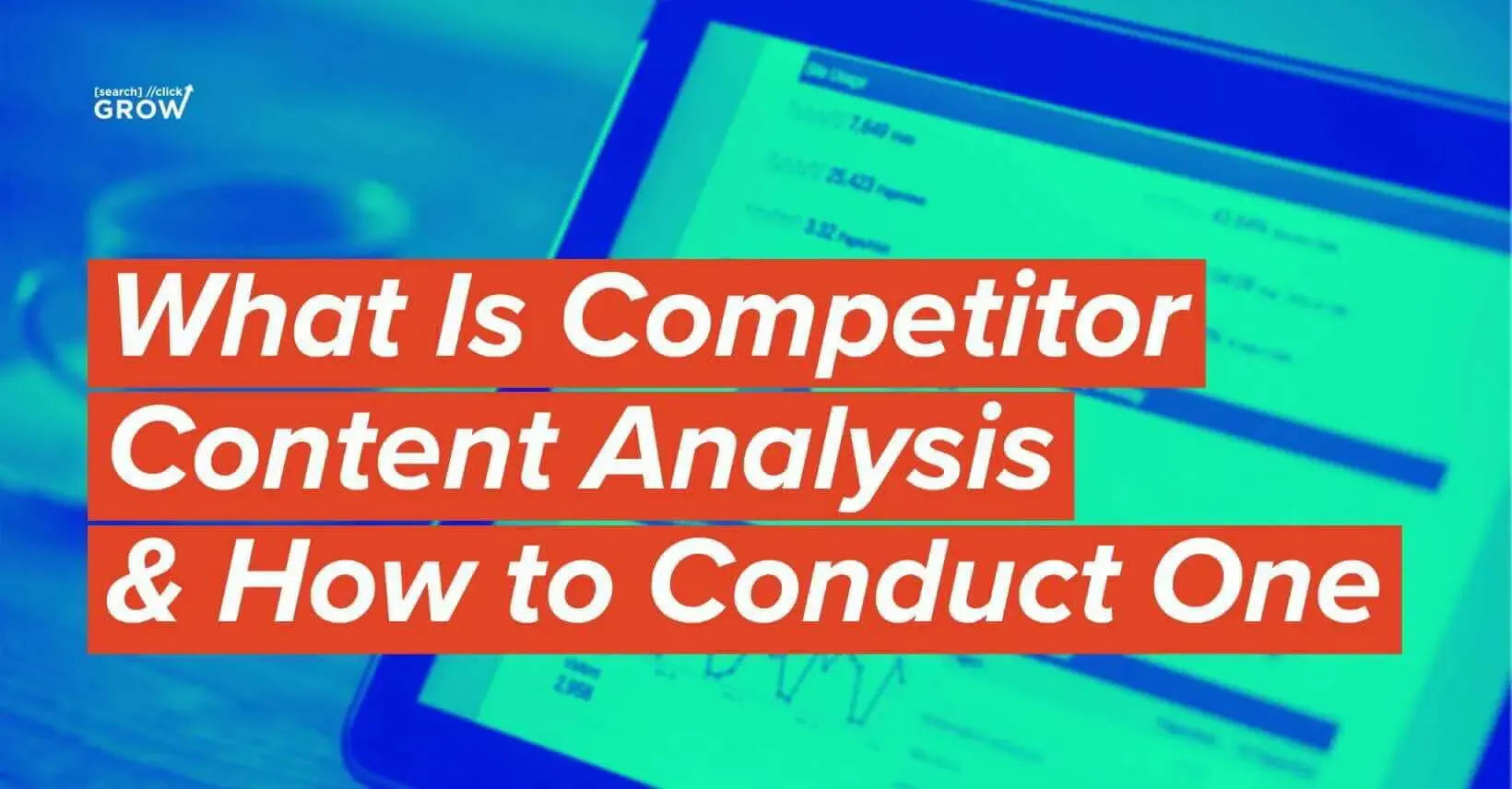
What Is Competitor Content Analysis and How to Conduct One
Competition is everywhere. In today’s digital age, your competition is not just the businesses down the street. With a global market and social media at our fingertips, companies large and small are vying for attention from the same customers that you are.
This is why competitor content analysis is so important. By analyzing what your competition is doing online, you can keep tabs on their activities, learn from their successes and failures, and adapt your content strategy accordingly.
But what exactly is competitor content analysis? How can you conduct one for your business?
This article will explain competitor content analysis, why businesses should conduct one, and how to run one. Ready?
Let’s get started.
What Is Competitor Content Analysis?
Competitor content analysis evaluates what competitors’ businesses say online and determines how that compares to your business goals and messaging.
This process can be conducted for various reasons, including:
- Understanding what content is resonating with your competitor’s audience
- Gauging their online presence’s overall tone and approach
- Identifying potential areas where you could improve your content strategy
By analyzing competitor content, you can better understand what’s working well for them and adapt those strategies to your business. Additionally, competitor content analysis can help you identify potential gaps in their content strategy that you could exploit to gain an advantage.
Why Conduct a Competitor Content Analysis?
There are many reasons to analyze competitor content, but here are some of the most common.
1. Understand What Content Is Resonating With Their Audience
When you analyze your competitor’s content, you can get a good sense of what topics and types of content resonate with their audience. This information can help shape your content strategy.
- You can see what topics get the most engagement and focus on creating content around those topics.
- You can also get ideas for new types of content to try based on what is working for your competitor.
For example, if you see that your competitor’s blog post about a new product launch gets a lot of comments and shares, you might want to write a similar post when you launch a new product. Or, if you see that your competitor’s infographics get a lot of shares, you might want to create an infographic of your own.
2. Gauge the Overall Tone and Approach of Their Online Presence
In addition to understanding what content is resonating with their audience, you can also get a sense of their online presence’s overall tone and approach. This information can help you adjust your tone and approach as needed.
To get a sense of their overall tone, ask yourself:
- How formal or informal is their language?
- Do they use a lot of industry jargon?
- Are they trying to be funny or serious?
- What kind of emotions does their content provoke?
You can also examine their website’s overall design and feel. Is it clean and minimalistic, or does it have many bells and whistles? These design choices can give clues about their overall approach and what they’re trying to achieve with their content.
Understanding their overall tone and approach ensures that your content is complementary and doesn’t come across as too sales-y or pushy.
3. Identify Potential Areas Where You Could Improve Your Content Strategy
In every business, there is room for improvement. No matter how great your content is, someone out there always does it better. The goal of competitor content analysis is to help you find areas where you could improve your content strategy.
Finding competitor content that outperforms your own can be frustrating, but it’s worth analyzing why their content is doing better. Understanding their success allows you to make the necessary changes to improve your content strategy.
Let’s say that you notice that one of your competitor’s blog posts has been shared a lot more than any of your own. After reading the post, you realize it’s much shorter than your posts and easier to read. You also notice that they use a lot of subheadings, images, and lists.
Based on this competitor content analysis, you could improve your content strategy by writing shorter blog posts that are easier to read. You could also use more subheadings, images, and lists to break up your content and make it more visually appealing.
Of course, you don’t want to copy your competitor’s content exactly. However, you can make the necessary changes to improve your content strategy by understanding what makes their content successful.
4. Find Gaps in Their Content Strategy That You Could Exploit To Gain an Advantage
It is not uncommon for businesses to have gaps in their content strategy. These gaps are opportunities to exploit to gain an advantage over your competitor. The more you know about your competitor’s content strategy, the more prepared you will be to take advantage of these opportunities.
Finding gaps in your competitor’s content strategy can be difficult but not impossible. There are a few methods you can use to uncover these gaps.
- One method is to analyze your competitor’s website. Look at their blog and see what topics they are writing about. Then, look at the social media accounts associated with their website and see what content they are sharing on those platforms. Based on this analysis, you should be able to identify any gaps in their content strategy.
- Another method you can use to find gaps in your competitor’s content strategy is to conduct a content audit. A content audit analyzes all the content your competitor has published on their website and other platforms. This will give you a good overview of what topics they are covering and what topics they are not.
Once you have identified any gaps in their content strategy, you can start to create content that fills those gaps. This will give you a leg up on your competitors and help you attract more viewers and potential customers.
How to Conduct a Competitor Content Analysis In 5 Steps
Now that you know competitor content analysis and its importance, it’s time to learn how to conduct one.
Luckily, conducting a competitor content analysis is not as difficult as it may seem. It can be broken down into 5 simple steps.
Step 1: Select Competitors
The first step in conducting a competitor content analysis is to select your competitors. Ideally, you should select three to five companies similar to yours in size, industry, and location.
Once you have selected your competitors, look at their websites and social media platforms to get an idea of the type of content they produce and how often they publish new content.
There are types of competitor companies you should be aware of:
- Direct: These are companies that offer the same products or services as you do. They are your main competition and the ones you need to watch closely.
- Indirect: These are companies that offer products or services that complement yours. They are not direct competitors, but they could be a threat if they start producing similar content to yours.
- Partner: These are companies you have partnered with in the past or present. You may not consider them competition, but monitoring their content is still important to ensure they are not undercutting your business.
Knowing the different types of competitor companies, you can develop a content strategy that is unique to your business and will help you stand out from the competition. This way, you can attract more customers and grow your business.
Step 2: Gather Data
Now that you have selected your competitor companies, it’s time to gather data about them. This data will be used to analyze their content strategy and identify any gaps you can exploit.
There are a few different ways to gather competitor data:
- Use competitor analysis tools: The most common method is to use competitor analysis tools, such as BuzzSumo, Moz, and SEMrush. These tools track competitor activity across the web and social media.
- Conduct a manual online search: Another option is to manually search for competitor information online. This can be done by conducting competitor website audits and competitor keyword research.
Once you have collected competitor data, it’s time to analyze it. This will help you understand their content strategy and identify gaps in their approach.
Step 3: Content Audit
A content audit is a comprehensive analysis of all your competitor’s published content, including their website, blog posts, social media posts, and any other content they have published online.
A content audit will give you an overview of what topics your competitor is covering and how often they publish new content. This information can help identify gaps in your competitor’s content strategy that you can fill with your content.
To conduct a content audit, create a spreadsheet with all of your competitor’s content. Include the following columns:
- URL
- Title
- Publish date
- Topic
- Type of content (e.g., blog post, social media post, etc.)
- Frequency
Once you have created your spreadsheet, you can begin filling it out by conducting a search for your competitor’s website. Start with their homepage and look for any published blog posts or articles. Once you find one, add the URL, title, publish date, topic, and type of content to your spreadsheet.
Repeat this process for each piece of content you find until you have an exhaustive list of your competitor’s online content.
When you have finished your content audit, you should understand what topics your competitor is covering and how often they publish new content. This information can help identify gaps in your competitor’s content strategy that you can exploit.
Step 4: Tools and Tactics
Now that you understand your competitor’s content strategy, it’s time to develop a plan to outrank them. This plan should include a mix of SEO and content marketing tactics.
Some tactics you can use to outrank your competitor’s content include:
- Creating more comprehensive articles: If your competitor’s articles are shorter than yours, adding more content to your articles can help you rank higher.
- Optimizing your website for SEO: Ensure your website is optimized for SEO. This includes optimizing your title tags, meta descriptions, and headers.
- Promoting your content: Once you’ve published a piece, promote it on social media and other channels. You can also use paid advertising to promote your content.
- Building links: One of the most important ranking factors is backlinks. To improve your ranking, try to get high-quality links from relevant websites.
- Monitoring your competitor’s activity: Keep an eye on what your competitor is doing. If they publish a new article, quickly follow up with one of your own.
Using a mix of SEO and content marketing tactics, you can outrank your competitor’s content and improve your chances of driving traffic to your website.
Step 5: Act on Your Findings
After you have conducted your competitor’s content analysis and developed a plan to outrank their content, it’s important to take action. Begin implementing your SEO and content marketing tactics and monitoring your results.
As you implement your tactics, continue to monitor your competitors’ activity. If they change their content strategy, adjust your tactics accordingly to stay one step ahead.
By conducting a competitor content analysis and taking action on your findings, you can improve your chances of driving traffic to your website and achieving your business goals.
Conclusion
A competitor content analysis involves examining your competitor’s website to understand what type of content they are creating, how it is formatted, and where it is being published. The goal of this analysis is to better understand your competitor and determine if you can create similar or better content that will help you attract their customers.
There are several different ways to conduct a competitor content analysis, but all involve studying your competitor’s website closely to gain insights into their marketing strategy.
Once you have gathered this information, you can begin developing your strategy using the competitor content analysis findings and apply them to improve your website.
When done correctly, a competitor content analysis can be an extremely valuable tool that can help you take your business to the next level.
If you are unsure how to get started, many online resources can help, including competitor content analysis templates and tutorials. With a little time and effort, you can be on your way to outranking your competitor’s online presence.






